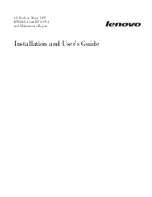
31
Conditions
Possible cause
Action
Bypass mode
LED is on.
An overload or a fault has
occurred, or a command has
been received and the UPS is
in Bypass mode. Or auto
bypass function is enabled.
Equipment is powered but not protected
by the UPS. Check for one of the following
alarms: overtemperature, overload, UPS
failure or auto bypass setting.
Power overload
LED is On.
1 beep every
second.
Power requirements exceed
the UPS capacity (greater
than 105% of nominal;
Remove some of the equipment from the
UPS. The alarm resets when the condition
becomes inactive.
over temperature
warning
LED is On.
1 beep every
second.
The UPS internal
temperature is too high. At
the warning level, the UPS
generates the alarm but
remains in the current
operating state.
Clear vents and remove any heat sources.
Ensure the airflow around the UPS is not
restricted.
The UPS does not
start.
The input source is not
connected correctly.
Check the input connections.
The Remote Power Off
(RPO) switch is active or the
RPO connector is missing.
If the UPS Status menu displays the
"Remote Power Off" notice, inactivate the
RPO input.
Emergency power
off
RPO is active
1.
Check the RPO connector status
2.
Reset the RPO fault through LCD. Main
menu
–
Control - Reset fault state.
Fan fault
Fan abnormal
Check if the fan is running normally
Site fault
Phase and neutral conductor
at input of UPS system are
reversed
Site Fault detection disabled by default.
It can still be enabled / disabled from the
LCD settings menu.
Reconnect all input wires.
Over temperature
fault
Over temperature is too
high, UPS goes to bypass or
stopped.
Check the ventilation of the UPS and
check the ambient temperature.
Output short circuit
Output short circuit
occurred
Check the output of UPS and loads, make
sure the short circuit is removed before
turning on again.
APP cannot connect
to UPS
IoT is disabled
Enable IoT function in LCD
Your IT settings may block
UPS get cloud connected
(NTP, Proxy, etc.)
please refer to WinpowerView app help
file
Summary of Contents for 10122192
Page 10: ...5 2 2 Rear panels Tower 1K 1KS 1 5K 1 5KS Tower 2K 2KS ...
Page 11: ...6 Tower 3K Tower 3KS ...
Page 12: ...7 Tower EBM RT 1K 1KS 1 5k 1 5KS RT 2K 2KS 36V 72V 5 5 8 8 10 5 3 1 7 8 4 6 2 13 11 ...
Page 20: ...15 2k 3k 3 4 2 RT models ...
Page 40: ......
Page 46: ...8 1 USV Schaltdiagramm 33 8 2 USV Spezifikation 33 ...
Page 51: ...5 2 2 Rückseiten Tower 1K 1KS 1 5K 1 5KS Tower 2K 2KS Schuko Thai Schuko Thai ...
Page 52: ...6 Tower 3K Tower 3KS Schuko Thai Schuko Thai ...
Page 53: ...7 Tower EBM RT 1K 1KS 1 5k 1 5KS RT 2K 2KS ...
Page 61: ...15 2k 3k 3 4 2 RT Modelle ...
Page 91: ...5 2 2 Panneaux arrières Tour 1K 1KS 1 5K 1 5KS Tour 2K 2KS Schuko Thai Schuko Thai ...
Page 92: ...6 Tour 3K Tour 3KS Schuko Thai Schuko Thai ...
Page 93: ...7 MBE en Tour RT 1K 1KS 1 5k 1 5KS RT 2K 2KS ...
Page 101: ...15 2k 3k 3 4 2 Modèles RT ...
Page 114: ...28 ...
















































